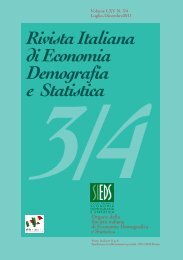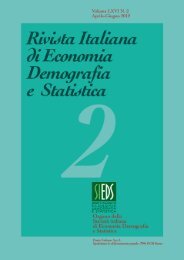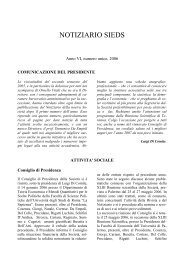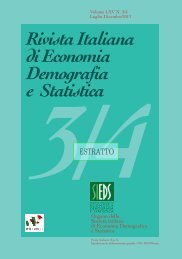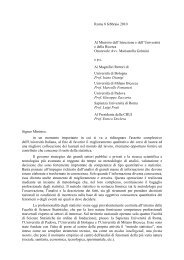rivista italiana di economia demografia e statistica - Sieds
rivista italiana di economia demografia e statistica - Sieds
rivista italiana di economia demografia e statistica - Sieds
Create successful ePaper yourself
Turn your PDF publications into a flip-book with our unique Google optimized e-Paper software.
166<br />
Volume LXIII nn. 3-4 – Luglio-Dicembre 2009<br />
contextual covariates. We define the <strong>di</strong>screte latent random variable X ij<br />
that<br />
represents the in<strong>di</strong>vidual con<strong>di</strong>tion of social exclusion. Given their response<br />
patterns to the selected in<strong>di</strong>cators, in<strong>di</strong>viduals will be classified in a probabilistic<br />
way in one of the t = 1,..., T latent classes of X ij<br />
. Moreover, we assume the<br />
existence of a <strong>di</strong>screte latent random variable W j<br />
at regional level, with<br />
m= 1,..., M classes, con<strong>di</strong>tionally on which the in<strong>di</strong>vidual responses are assumed<br />
to be mutually independent. The second level latent variable has the role of a<br />
random effect in the model for X<br />
ij<br />
, and it aims to identify latent types of regions<br />
for which parameters in the specified model <strong>di</strong>ffer. This multilevel specification of<br />
the latent class probability structure is built by introducing a finite mixture model<br />
at each level of nesting (Vermunt 2003), i.e. at the in<strong>di</strong>vidual and regional level:<br />
M<br />
n<br />
( )<br />
j T<br />
K<br />
⎡<br />
g<br />
⎡<br />
⎤⎤<br />
P Yj Z<br />
j<br />
= ∑⎢PW ( = mZ<br />
) ( , ) ( ,<br />
j j ⎢∏∑P X = tW Z PY s X W<br />
ij j ij ∏ =<br />
ijk k ij j ) ⎥⎥<br />
m= 1⎣<br />
⎣ i= n t=<br />
1 k=<br />
1<br />
⎦⎦<br />
The three components of the right-hand side of the previous equation are specified<br />
using multinomial logit models, and represent:<br />
a) the probability that region j belongs to a particular level of the latent<br />
g<br />
variable W , given the three selected regional covariates Z ;<br />
j<br />
j<br />
b) the probability that respondent i belongs to a particular class of the latent<br />
variable at the first level X<br />
ij<br />
, given regional latent class membership and the<br />
two in<strong>di</strong>vidual covariates Z ;<br />
ij<br />
c) the joint probability that the i -th respondent follows the pattern s i<br />
given<br />
in<strong>di</strong>vidual and regional latent class membership. In order to account for<br />
variability of item response among <strong>di</strong>fferent regions, we hypothesized some<br />
<strong>di</strong>rect effects of the group-level latent variable.<br />
4. Results<br />
The model <strong>di</strong>scussed here identifies 6 <strong>di</strong>fferent respondent types as regard their<br />
deprivation status in all the relevant domains, i.e. T = 6 latent classes at in<strong>di</strong>vidual<br />
level, and of 4 classes at regional level, i.e. M = 4 (subsequently in<strong>di</strong>cated as<br />
“clusters”) which enable to <strong>di</strong>fferentiate rather well among regions. The model has<br />
been selected by means of the BIC statistics.<br />
The characteristics of each class, in terms of their similarities and <strong>di</strong>fferences,<br />
can be <strong>di</strong>scussed referring to the class-specific marginal probabilities associated



